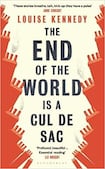
Is any reading experience more powerful than a brilliantly orchestrated set of fine short stories? Not just the individual pieces but also the interplay of thematic rhymes, chimes, resonances and inversions, some planned by the author, others perhaps accidental, many not quite accidents but symmetries stirred by fate or the reader’s own experience?
In the novel, as in all storytelling, every sentence needs to count, but there are moments, brief paragraphs, when the novelist can loosen the rhythm, ostensibly in the name of texture or style (although the reader may appreciate a breather, too). There is nowhere in the short story for the author to hide since its crannies and shadows are often where the story is coming from. As Flannery O’Connor remarked, in good fiction “two plus two always equals more than four”. Much is in what’s not being said.
Louise Kennedy’s outstanding debut collection, The End of the World is a Cul De Sac, contains 15 stories, each a scrupulously worked dark gem. She is a storyteller of stunning gifts and immense authority; as with O’Connor, you never catch up with her, still less overtake her. She is technically brilliant – her mastery of the second-person narrative in the story In Silhouette is unerring and remarkable – and also the conjurer of a unique vision, a take on the world all her own.
You think you know what you’re reading but in an instant you don’t. The reader steps into the lift but Louise Kennedy has taken over the controls and suddenly you’re dropping down a shaft you didn’t even notice was there. So, a story about a donkey getting loose in a ghost estate (“it pawed and snattered”) becomes something very different, a tale we think might be a love story before it unfurls jaw-droppingly into the opposite.
Changeling stories
A story about a North of Ireland teenager putting on make-up to go to a bar unleashes a narrative of other concealments and disguises. At the outset you think it might be a wry, funny story – a character is not allowed enter a chemist’s shop because “Mr Crawford, the owner, is in the DUP” – like something written by a Lower Falls Lorrie Moore. But it shimmers into a mosaic of astonishing violence and memory. Louise Kennedy’s stories are changelings.
Part of her power is in the physical descriptions that seem at once pared-back but weirdly freighted. In the shocking, compelling, brilliantly structured opening story, a man “leaned in the doorway and lit a cigarette. His shoulders were taut, as though he was trying to appear smaller. The beard both became him and made him unremarkable … The driver got out. He had greased-back red hair and an off-the-rack suit.”
In another story, “Elaine went to the front door, the entrance they never used. She opened it to the three of them, a slight man in a grey suit flanked by two shaven-headed men in black jackets like the one bouncers wear.” You know something is wrong before she tells you what it is. In fact, usually she doesn’t tell you. You twig it.
The country in which these characters exist seems to have hidden rooms within rooms. An Ireland of fairy forts, folklore, sheela-na-gigs, hare myths, poets’ graves and overgrown Famine-era follies coexists with a strange, somehow superimposed land of Facetiming, tan salons, cannabis grow houses, fast food and video horseracing in bars. There’s a tension between past and present, yet they’re part of each other, a dysfunctional couple unable to split.
If the natural world sometimes offers consolation – “each season brought something on: primroses and wood anemones in spring” – it also disconcerts. “She stopped to show him broomrape, a rare plant that could not take in light and lived as a parasite on the roots of ivy.” Imagine a language that has all the capacities and beauties of English finding a name such as that for a plant.
Female bodies
Readers interested in the subject of the body in literature will find much in this collection. Intermittently throughout the book a female body is painted, shaved, shot, stitched, used, mocked, drugged, hunted, deployed as means of blackmail against itself. The vision the writing embodies is unsparing and unsettling, set out with skill and force. Very occasional glints of humour silver the prose like headlights glimpsed through a rainswept window. In the States, the only place to buy good food is “a farmers’ market from a hipster with an MBA”.
How do great short stories such as these create their three-dimensionality? By knowing what not to say. Louise Kennedy’s control of the material is extraordinarily deft. Always she leaves something for the reader to do, in that way unlocking a door that we push at. Each story in this collection is a masterclass in narrative control. The pace of the writing is perfect.
It carries and enables the atmosphere of sad menace that wafts itself around these characters and their evasions. This is writing that makes Francis Bacon at his bleakest seem like Mary Poppins. I am haunted by these unforgettable short stories and believed every single line of every one of them. Louise Kennedy is a very major talent.
Joseph O’Connor’s latest novel, Shadowplay, is published in paperback by Vintage. He is professor of creative writing at the University of Limerick











